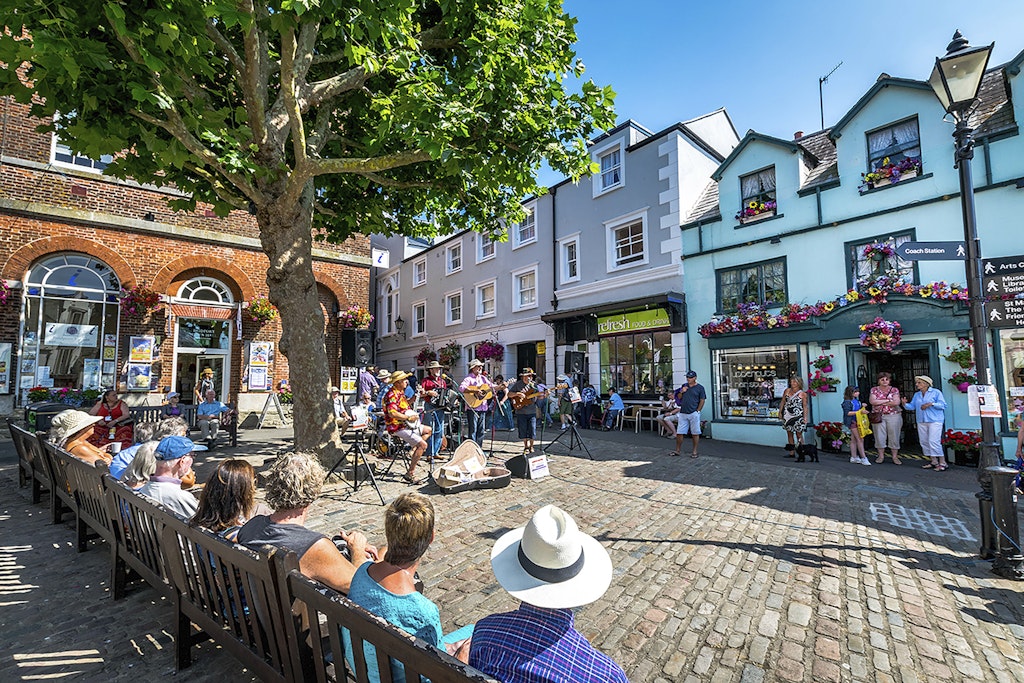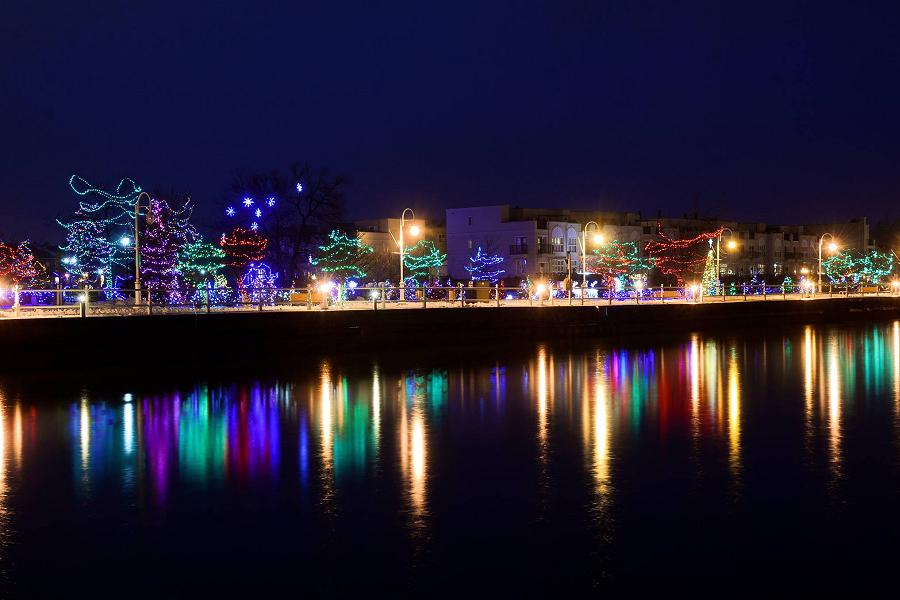lenaitch
Senior Member
May I suggest my hometown of Port Perry. Waterfront park well lit up with Christmas lights right now.
Good point. I have no idea if or how the communities I have mentioned have 'winterized' their waterfronts.
May I suggest my hometown of Port Perry. Waterfront park well lit up with Christmas lights right now.
We think there are three big elements. The first is a profound failure of governance. For hundreds of years, English towns had been run by their corporations and alderman, regulating their markets, managing almshouses, licensing traders. Some were active. Some were sleepy. No doubt many were modestly corrupt. But the fortunes of the merchant mayors and councillors were tightly tied to that of their towns and, on the whole, they governed quietly.
No one could accuse twentieth-century town councils of lacking ambition. Overawed by town architects such as Donald Gibson in Coventry — who described German air raids as “a blessing in disguise” — and by prophets of “traffic modernism” as preached by the Architectural Review, they confused the intoxicating freedom of a rare car on a 1930s country road with how our towns centres should function.
The careful accretion of beautiful, practical human-scaled streets and squares — good for trading and talking, for meeting and living — was thus brutally swept away in the name of a false vision of progress: fast roads and overly-scaled, under-detailed buildings. Complex and adaptable towns were replaced with urban monocultures, often under single ownership which were unable to evolve.
If Britain is truly to prosper, we need stronger towns. This doesn’t mean naive “regional development policies” to “pick winners” or to subsidise employment where it would not otherwise go — the jobs tend to end when the subsidy evaporates. But it does mean allowing our towns to rediscover their true purpose as a place for people profitably to congregate for business and pleasure. And that will normally mean helping them become cleaner, more pleasant places in which it is easier and cheaper, to live, work, spend time, set up businesses and raise children. Towns like Bradford, Altrincham and Macclesfield are starting to achieve this through partially community-led high street revitalisation.
All politics is not local. Politics is place. Most of our towns are nearly 900 years old. Treat them with a little love and they will be good for thousands more to come. For all our technological advances, people, after all, are still the same.

Seaforth has one of the most intact 19th century Main Streets in Ontario. Unfortunately, not much economic on-goings there- but then again, I suppose the best way to preserve is to forget.Brockville and Goderich (moreso before the tornado) andperhaps Gananoque, in my view three of the prettiest towns in Ontario, have very walkable cores. No doubt, big-box-land has occupied the outer fringes.
Seaforth has one of the most intact 19th century Main Streets in Ontario. Unfortunately, not much economic on-goings there- but then again, I suppose the best way to preserve is to forget.
Better in the summer if work/lifestyle permits. I imagine the waterfronts are pretty bleak and uninviting this time of year and most amenities would be closed. Brockville refurbished their downtown railway tunnel (oldest in Canada apparently) as a tourist attraction. It's about 1/2 km long and the geology and 1850s construction is interesting if you are into such things. Alas, closed until Spring.



There are also lots of "weak" downtowns in the province, it just depends where you are. Simcoe, St Thomas, Brantford, etc. all have fairly poor downtowns. Brantford has been improving as of late, but it's not quite there yet.
My wife is from Simcoe, and it was really a shock when I first went there when we started dating. The downtown feels very american with essentially no major functions or useful retail spaces. No restaurants of note, etc. The library and Municipal offices are essentially the only reason to go there. Otherwise everyone drives right through to the strip on Highway 3. That type of downtown is common across the US, but less so in Ontario I find.. most small towns have managed to keep the cores at least semi relevant with restaurants, useful boutique shops (think book stores, bakeries, hair salons, etc.), nice park spaces, and some form of civic function, creating a reason for people to go there regularly. Some (like Port Perry) even manage to retain larger format retailers like grocers which successfully compete with the edge of town strip plazas.
I've never been to Goderich but what always stuck me about its downtown from looking at it on Street View is how wide the main street (the circle) is. It has diagonal parking, three full one way driving lanes, and another lane for parking. It's enormous. Some of the streets radiating out from the circle are actually worse, with around 7 lanes worth of pavement. Drastically reducing the road space on these streets would make a world of difference in complementing the unique town layout.Brockville and Goderich (moreso before the tornado) andperhaps Gananoque, in my view three of the prettiest towns in Ontario, have very walkable cores. No doubt, big-box-land has occupied the outer fringes.
1960’s planning was on another level. The province planned (and actually built the first few houses) a new city of 150,000 on the shores or Lake Erie, laid out the modern GTA highway network even though the first phase of the 401 had opened but a decade earlier, and saw the rapid growth outward of the suburbs.
stuff like square one was built because they knew the whole area would develop in quick order.
Much like how the Halton Hills outlet mall is in the middle of nowhere today, in 30 years it’ll be completely surrounded by development.
Was this supposed to be Nanticoke? Where can one learn more about that aborted plan?
It's actually Townsend, which is north of Nanticoke.
I find it very interesting how a larger city located on the Ontario side of Lake Erie never happened, considering Toledo, Cleveland, Erie, and Buffalo all exist. I've been out in Nanticoke/Port Dover area and it always seemed like it was supposed to be bigger than it actually was. Interesting to know that there was an attempt at making it happen.
This larger city on the Ontario side could have had Crystal Beach Amusement Park relocated there (and significantly expanded) to compete with Cedar Point in Sandusky, OH, which is across Lake Erie from Leamington, ON.
Maybe something that should not be ruled out completely long-term, given the GTA's rapid population growth. Though there remains the tricky problem that seemingly plagued the original plan of how do you induce employment to relocate to the new area? That Stelco steel mill in Nanticoke is probably not long for this world either.
That being said, there is a lot of land ripe for intensification in the GTA already, including here at Square One.
I wouldn't rule it out completely either, but I doubt it would be as a result of the GTA's growth. There is a lot of land to still be eaten up and intensified in Peel, York, Halton, Durham, and more by the GTA's growing footprint before anything near Lake Erie gets consumed. There are lots of other malls like SQ1 in the GTA that will be redeveloped eventually to create dense highrise communities. I doubt the GTA would even be able to get that large in footprint either.
Industry over there would not be enough to sustain a city, between the Stelco Plant, Imperial Oil Refinery, and the Port of Nanticoke, so any community there would have to be completely planned with the provincial/federal government having a heavy hand in building new industry. Even back in the day with the OPG coal plant, it still probably wasn't enough to sustain a full community, and it being shut down was probably the final nail in the coffin for the area.
As the wikipedia article said, instead of the growth concentrating in Townsend workers in those (new at the time) plants simply moved into existing communities in the area. Norfolk County has a population of a little under 70,000, just spread out over a large area. My in-laws live down there and my father in-law worked at the Nanticoke Generating Station for his whole career before he retired. They live in Simcoe, not Townsend.
Anyway, we are way off topic. Didn't mean to take it this way. Maybe we should start a thread elsewhere on the topic or something?
It is off topic but also kinda relevant. Ontario could really benefit from having another large urban area to help spread out the population a little bit.
Outside of the gta (+hamilton) theres basically just kw+guelph and london. Given we're surrounded by lakes there's definitely place for new urban centers to rise. Doesnt even have to be along Erie. I could see something along the shores of huron popping up to. Particularly Georgian bay given its proximity to Barrie
Why not Barrie itself? I could easily see it growing to +500k.
It is off topic. If you'd like to continue down the New Town Road (sorry), please create a new thread in the General Discussions forum!
42
Bringing discussion over from another thread. The question asked is "Would Ontario benefit from having another large urban area to help spread out the population a little bit?"
I enjoy the idea of strong mid-size cities. I am not sure about the viability of creating a new urban centre from scratch, but I do see places like Niagara Region with it's various population centres rapidly growing in the coming decades.
Also noted in the previous discussion that it is quite peculiar that Southern Ontario does not have any large population centre on the banks of Lake Erie or Lake Huron. If creating a new urban centre from scratch, where should one be placed?
In terms of a new population centre on Lake Huron or Lake Erie, it becomes a harder question because the coast lines are so far out of the provincial paths of commerce. For Lake Erie, I figure the closest shot would be seeing London sprawl towards the lake and eventually merge with St. Thomas and Port Stanley. I see it being more viable on Lake Huron, with Wasaga Beach, Collingwood, and Barrie all eventually growing into one area.




